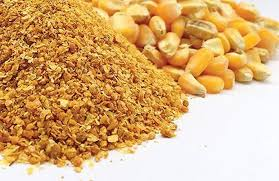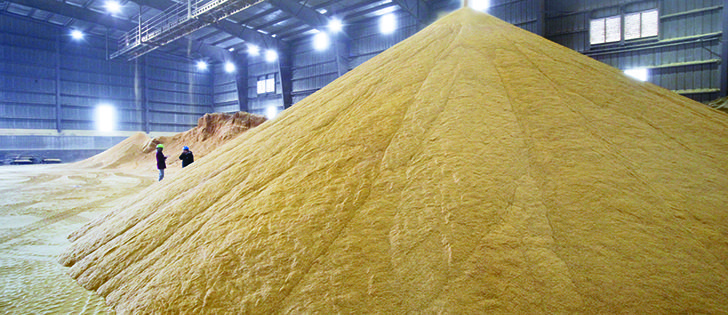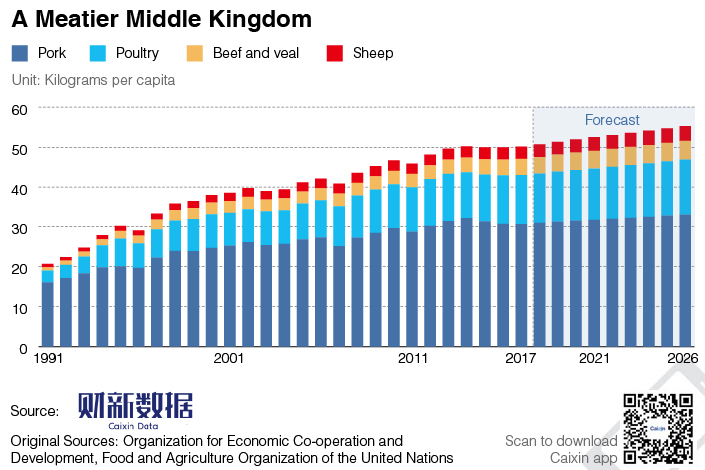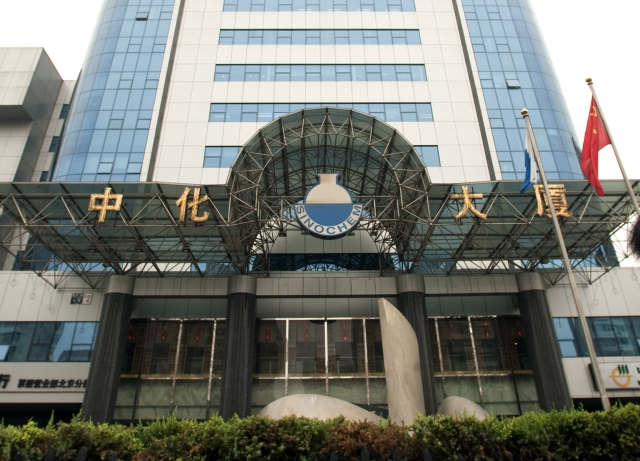𝐂𝐡𝐢𝐧𝐚 𝐚𝐧𝐝 𝐏𝐫𝐨𝐭𝐞𝐢𝐧
The axis of the world turns upon control of four resources:
Protein
Water
Energy
Firepower
The first is the subject of this thread.
China& #39;s enormous population demands massive amounts of protein.
And a war is on for it.
1/
The axis of the world turns upon control of four resources:
Protein
Water
Energy
Firepower
The first is the subject of this thread.
China& #39;s enormous population demands massive amounts of protein.
And a war is on for it.
1/
Christmas Eve 2013, panicked calls to logistics managers working in the grain industry began flooding in.
Without notice, China had banned the import of any corn or corn co-product that contained more than a tiny trace of Syngenta& #39;s MIR162 transgenic trait.
2/
Without notice, China had banned the import of any corn or corn co-product that contained more than a tiny trace of Syngenta& #39;s MIR162 transgenic trait.
2/
MIR162 (trade name "Viptera") was in its first full year of mass market release, spanning many hybrids of corn.
The trait is designed to kill insects that feed on corn plants, particularly various worms and corn borers.
These insects can devastate a farmer& #39;s bottom line.
3/
The trait is designed to kill insects that feed on corn plants, particularly various worms and corn borers.
These insects can devastate a farmer& #39;s bottom line.
3/
The problem is, Syngenta hadn& #39;t secured final regulatory approval in the largest foreign market for US corn products:
China.
The nation is an enormous consumer of corn protein sources for its domestic livestock and poultry industries, and had been the demand bull for years.
4/
China.
The nation is an enormous consumer of corn protein sources for its domestic livestock and poultry industries, and had been the demand bull for years.
4/
But China was battling a domestic issue.
The booming middle class was demanding more animal protein than ever.
The government was desiring a move to greater food security, especially domestic production of critical feed ingredients.
Corn production had to be incentivized.
5/
The booming middle class was demanding more animal protein than ever.
The government was desiring a move to greater food security, especially domestic production of critical feed ingredients.
Corn production had to be incentivized.
5/
Unexpected record yields in 2013 tanked the domestic price, triggering price supports and massive government purchases of corn from Chinese farmers to keep them solvent.
However, Chinese protein buyers preferred a different ingredient for their feed blends:
DDGS.
6/
However, Chinese protein buyers preferred a different ingredient for their feed blends:
DDGS.
6/
DDGS, or Distillers Dried Grains w/ Solubles, are the main co-product of the traditional corn ethanol production process.
With the Obama admin& #39;s expansion of the Renewable Fuel Standard (RFS) to blend 16.55B gallons of biofuels into the US fuel supply, ethanol was booming.
7/
With the Obama admin& #39;s expansion of the Renewable Fuel Standard (RFS) to blend 16.55B gallons of biofuels into the US fuel supply, ethanol was booming.
7/
DDGS are considered to be a more efficient feedstock for swine than corn/soybean meal rations, with most estimates being 1 MT of DDGS replacing roughly 1.22 MT of corn/SBM.
And as the largest corn ethanol producer in the world, China depended on the US for this ingredient.
8/
And as the largest corn ethanol producer in the world, China depended on the US for this ingredient.
8/
After harvest 2013, China found itself with a dilemma and an opportunity.
Dilemma: oversupply of domestic corn with a better ingredient cheaply available from a frenemy nation
Opportunity: stage a conflict and lay the groundwork for better food security
9/
Dilemma: oversupply of domestic corn with a better ingredient cheaply available from a frenemy nation
Opportunity: stage a conflict and lay the groundwork for better food security
9/
It& #39;s important to understand a certain trade tactic employed by nations (especially China).
Often, the nation will soft-approve some new tech without formally approving it.
They will look the other way as it builds importance - until it becomes a big enough trade weapon.
10/
Often, the nation will soft-approve some new tech without formally approving it.
They will look the other way as it builds importance - until it becomes a big enough trade weapon.
10/
However, there is all the difference in the world for World Trade Organization partner countries between tacit and formal approval.
This is exploitable by unscrupulous nations.
A full-on ban would have triggered a WTO complaint by the US.
A "soft ban" is harder to prove.
11/
This is exploitable by unscrupulous nations.
A full-on ban would have triggered a WTO complaint by the US.
A "soft ban" is harder to prove.
11/
This is what China did. They did not fully ban corn imports with ANY of the unapproved MIR162 trait.
They just made the threshold low enough that it was virtually impossible for any corn shipments to pass.
Testing for the trait was also notoriously unreliable and corrupt.
12/
They just made the threshold low enough that it was virtually impossible for any corn shipments to pass.
Testing for the trait was also notoriously unreliable and corrupt.
12/
The new import regime on corn went into place on Christmas Eve 2013.
Nearly every American grain exporter was caught pants-down.
Many thousands of ocean containers, bulk vessels, trucks and railcars were in transit to deliver DDGS to China.
Everything ground to a halt.
13/
Nearly every American grain exporter was caught pants-down.
Many thousands of ocean containers, bulk vessels, trucks and railcars were in transit to deliver DDGS to China.
Everything ground to a halt.
13/
When the dust settled, and everything tallied, multiple companies had gone bankrupt, and the estimated economic damage to US farmers and companies totaled north of $5 billion.
It was devastating.
But no one was more impacted than Syngenta.
14/
It was devastating.
But no one was more impacted than Syngenta.
14/
Overnight, the once-proud reputation of the powerhouse company was torched.
Farmers fled from Syngenta crop chemicals, corn and soybean hybrids, and transgenic traits that were being cross-marketed with other brands.
A billion-plus dollar class action suit was launched.
15/
Farmers fled from Syngenta crop chemicals, corn and soybean hybrids, and transgenic traits that were being cross-marketed with other brands.
A billion-plus dollar class action suit was launched.
15/
Its value tumbling, Syngenta hit the skids.
Sales for 2014 were strong due to farmers& #39; habit of pre-purchasing most inputs the year prior, but in 2015 global revenues fell by almost $2 billion.
The company was quietly looking for help.
16/
Sales for 2014 were strong due to farmers& #39; habit of pre-purchasing most inputs the year prior, but in 2015 global revenues fell by almost $2 billion.
The company was quietly looking for help.
16/
In 2013, the China Oil and Food Corporation (COFCO) was the largest buyer of DDGS.
A true state-owned enterprise, the megacompany is figurehead of all things grain-related in China.
The chairman at the time was a man named (Frank) Ning Gaoning.
17/
A true state-owned enterprise, the megacompany is figurehead of all things grain-related in China.
The chairman at the time was a man named (Frank) Ning Gaoning.
17/
COFCO was the first entity to enforce the overnight "ban" on American corn product imports, and also acted as a primary clearinghouse internally to resolve the oversupply of Chinese corn as the feed mills adjusted their blends.
Mr Ning was at the very heart of the process.
18/
Mr Ning was at the very heart of the process.
18/
Food prices are a leading indicator of potential civil unrest.
The exploding demand for protein increased prices in China for years prior to 2013.
COFCO and other companies would be critical to enacting a more balanced domestic protein industry to feed the Chinese people.
19/
The exploding demand for protein increased prices in China for years prior to 2013.
COFCO and other companies would be critical to enacting a more balanced domestic protein industry to feed the Chinese people.
19/
Throughout 2014, the drumbeat of "food security" continued to resonate in China.
That meant modern solutions - better equipment, better planning, better hybrids, better genetic traits, and better chemistry.
Only six companies had the means to provide all of those at once.
20/
That meant modern solutions - better equipment, better planning, better hybrids, better genetic traits, and better chemistry.
Only six companies had the means to provide all of those at once.
20/
The "Big Six" of modern, conventional agriculture are:
- BASF
- Bayer
- Dow
- DuPont
- Monsanto
- Syngenta
These giants live at the nexus of R&D, formulation, production, and distribution of BOTH seeds and pesticides.
For China to get into the game, it had to buy one.
21/
- BASF
- Bayer
- Dow
- DuPont
- Monsanto
- Syngenta
These giants live at the nexus of R&D, formulation, production, and distribution of BOTH seeds and pesticides.
For China to get into the game, it had to buy one.
21/
Dow and DuPont were already in bed. They were out.
BASF didn& #39;t want to sell. Bayer had its eyes on Monsanto.
That left Syngenta, who was suffering huge losses due to the COFCO-enforced ban on American corn products.
The Chinese-created crisis had weakened a key target.
22/
BASF didn& #39;t want to sell. Bayer had its eyes on Monsanto.
That left Syngenta, who was suffering huge losses due to the COFCO-enforced ban on American corn products.
The Chinese-created crisis had weakened a key target.
22/
In late 2015/early 2016, two events happened:
1. Mr Frank Ning left COFCO and took over as CEO of Sinochem, one of two main chemical companies in China
2. ChemChina (Sinochem& #39;s rival) completed its purchase of Syngenta for $43B.
The shape of things to come...
23/
1. Mr Frank Ning left COFCO and took over as CEO of Sinochem, one of two main chemical companies in China
2. ChemChina (Sinochem& #39;s rival) completed its purchase of Syngenta for $43B.
The shape of things to come...
23/
For years, Chinese leaders had been hoping to accomplish two goals:
1. Improve domestic food security
2. Reduce American influence in the Chinese food supply chain
A merger of the two companies, ownership of one of the Big Six, being led by a Cofco capo?
What a plan...
24/
1. Improve domestic food security
2. Reduce American influence in the Chinese food supply chain
A merger of the two companies, ownership of one of the Big Six, being led by a Cofco capo?
What a plan...
24/
As of one week ago, the merger was moving forward.
Frank Ning, the architect of Syngenta& #39;s pain and subsequent sale, will ultimately be the man in charge of China& #39;s burgeoning idigenous seed, chemical, and research sector.
https://www.reuters.com/article/us-sinochem-chemchina-merger/sinochem-chairman-says-merger-with-chemchina-still-underway-idUSKBN1XG151
25/">https://www.reuters.com/article/u...
Frank Ning, the architect of Syngenta& #39;s pain and subsequent sale, will ultimately be the man in charge of China& #39;s burgeoning idigenous seed, chemical, and research sector.
https://www.reuters.com/article/us-sinochem-chemchina-merger/sinochem-chairman-says-merger-with-chemchina-still-underway-idUSKBN1XG151
25/">https://www.reuters.com/article/u...
This thread is an example of how authoritarian regimes function internally.
You learn little from the powerful men who speak from a podium.
You watch for the domain-specific power brokers who make the real moves behind the veil of commerce and trade.
PEOPLE MOVE ASSETS.
26/
You learn little from the powerful men who speak from a podium.
You watch for the domain-specific power brokers who make the real moves behind the veil of commerce and trade.
PEOPLE MOVE ASSETS.
26/
It is deadly business to underestimate an opponent that sees timelines in decades, not 3-year earning cycles.
Only by looking backwards can we see the plan in action.
This wasn& #39;t a conspiracy.
It was a masterful plan, skillfully executed across multiple levels of impact.
27/
Only by looking backwards can we see the plan in action.
This wasn& #39;t a conspiracy.
It was a masterful plan, skillfully executed across multiple levels of impact.
27/
Just like my with threads on the #BeltandRoad, we can see that China is playing for keeps.
They want CONTROL of the means to serve the most basic human needs in the age of #durabledisorder:
Resources, production, and infrastructure.
https://twitter.com/man_integrated/status/1192489639547936768
28/">https://twitter.com/man_integ...
They want CONTROL of the means to serve the most basic human needs in the age of #durabledisorder:
Resources, production, and infrastructure.
https://twitter.com/man_integrated/status/1192489639547936768
28/">https://twitter.com/man_integ...
It is not just in the commodities and logistics domains that China is outfoxing the US.
They are exploiting gaps in US influence and force projection to take total control of their entire theater of influence at home. https://twitter.com/man_integrated/status/1195465368309059584">https://twitter.com/man_integ...
They are exploiting gaps in US influence and force projection to take total control of their entire theater of influence at home. https://twitter.com/man_integrated/status/1195465368309059584">https://twitter.com/man_integ...
The plot thickens as Belt and Road combines with weaponized diplomacy to cripple the US and NATO in the Indian Ocean. https://twitter.com/man_integrated/status/1195959412545994752?s=19">https://twitter.com/man_integ...
This will reframe the US/China trade war in a different, much graver context. https://twitter.com/man_integrated/status/1197153357347074048">https://twitter.com/man_integ...
The silent predators of the deep play a fundamental role in China& #39;s emergent militaristic ambitions. https://twitter.com/man_integrated/status/1197543841139691520">https://twitter.com/man_integ...
The Belt and Road Initiative is reshaping the geopolitical and logistics terrain. Necessarily, it will drag naval engagements closer to shore. The primarily blue-water US Navy is not ready. https://twitter.com/man_integrated/status/1196560926696235018">https://twitter.com/man_integ...
China is well-known for playing the angles in obscure ways to achieve long-term goals. What does their low-earth orbit satellite program have to do with Ukraine? https://twitter.com/man_integrated/status/1198406028146163713">https://twitter.com/man_integ...
President Erdogan of Turkey is fanatical in his pursuit of building a modern Ottoman Empire. What does this mean for Turkey& #39;s NATO allies, as well as Russia and China& #39;s Belt and Road? https://twitter.com/man_integrated/status/1200462867633455106">https://twitter.com/man_integ...

 Read on Twitter
Read on Twitter






